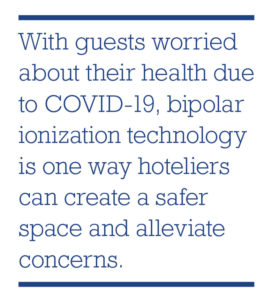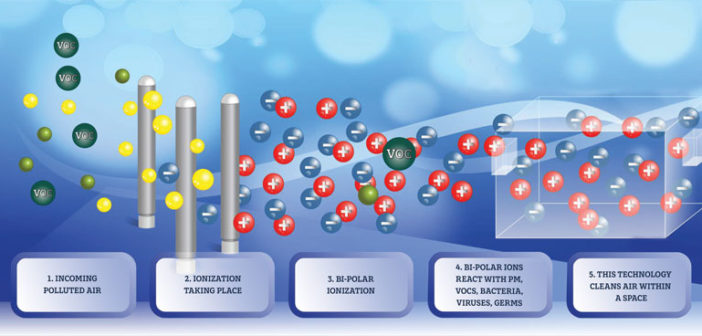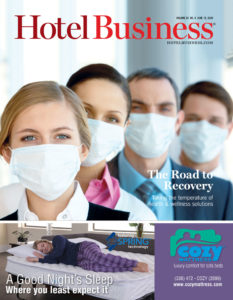 FAIRFIELD, CT—As hotels are beginning to welcome guests in increasing numbers after the COVID-19 pandemic shutdowns, a major priority has become finding ways to protect the health and safety of those guests and staff.
FAIRFIELD, CT—As hotels are beginning to welcome guests in increasing numbers after the COVID-19 pandemic shutdowns, a major priority has become finding ways to protect the health and safety of those guests and staff.
Some hotels have turned to bipolar ionization technology in their HVAC systems to neutralize viruses, including coronaviruses.
“As long as the air systems are working, we’re disinfecting the air,” said Steve Levine, CEO, AtmosAir Solutions. “We are scrubbing the air and pulling out the particulates and the spores, breaking down the volatile ionic compounds (VOCs) and the odors so it smells fresh and clean, and then attacking the different bacteria, viruses and germs so that they can’t live in an environment that has the AtmosAir system.”
The system uses ions to clean the air. “When you go to the top of a mountain, it smells fresh, it smells clean,” said Levine. “Why is that? At the top of a mountain, there is natural conductivity. That conductivity is caused by negative and positive ions. It is very prevalent at the top of the mountain, and very measurable. But when you start coming down the mountain, the ions have been depleted because of pollution, because of emissions. When you get into large cities, it is much less and when you get into interior environments, because of people, machines, carpets and things like that, the ions have been eaten up.”
The AtmosAir system utilizes specially designed bipolar ionization tubes that produce these ions. “We are really trying to create an additional layer of these ions that you would find in the mountains, and then let those ions attack the contaminants in the space,” he said. “The way ions do that is by grabbing onto particles. They make little particles bigger and heavier, so they are much easier to filter out of the air. Ions break down odors and VOCs. When you ionize a VOC or an odor, it is going to break that down into carbon dioxide and water vapor, which makes it smell fresher and cleaner.”
When it comes to combatting a virus, the ions surround it and puncture a hole in the virus so it can’t live. “Picture the spiky ball you see on TV with the needles coming out of it. The ions actually puncture that protein and make it inactive,” said Levine. “So, if that virus is sitting on a surface, and somebody touches that surface, they are not going to get sick. Or if the ions are in the air because someone sneezes or coughs and creates those droplets that are aerosolized or left on surfaces—and everybody is questioning how long they are left on surfaces—as long as the air system is on moving our ion system into the space, then those ions are attacking those viruses on surfaces and viruses that are in the air. Even if someone ingests the virus, with the ionization puncturing it and breaking it down, you are not going to get sick.”
But, Levine said, the system is not a silver bullet. “It is not going to prevent spread if someone is hugging another person and other person-to-person contact, but what it will prevent is if an infected person touches a surface, now that surface is clean and disinfected,” he said. “It is also going to fix what is floating in the air because the ions are scrubbing the air. It won’t take care of everything, but it will be one more layer on top of everything they are doing to get as close to that 100% as we possibly can.”
As such, this solution is best used in tandem with other sanitization methods.
He continued, “Our technology is all about one more layer of protection. You still have to wash your hands. You still have to clean your surfaces. You still have to change your filters. What our technology does is give the premise, ‘One more layer of continuous disinfection.’”
The company reports an increase in interest in its system since the pandemic began. Prior to that, the company worked with Hilton on its Five Feet to Fitness program, which focuses on the guestroom environment. “They were utilizing our technology in those special rooms to create a heathier, cleaner environment,” said Levine. “Now, with COVID-19, the issue is not just in the hotel rooms. The issue is in the lobby areas, the F&B areas, the banquet areas.”
This isn’t an issue for the company. “Our technology is scalable,” he said. “We are talking to a hotel in New York City that wants to put it throughout the entire hotel—not just the rooms, but where the employees are, where the guests first come in. They want to promote the idea because people are worried. When they come back to this new normal, they want to understand what a hotel has done to take steps against this virus that we are all facing. It has gone from a luxury to more of a necessity.”
Levine said that approximately 85% of the company’s business is retrofits into existing HVAC systems, and there are many ways the solution can be implemented. “It can go in the HVAC system itself, on the supply side of their air after the filters because we want to get as many ions into the target space as we possibly can,” he said. “It can also go in the supply duct. It sanitizes the duct at the same time, and then the ions spill out onto the space where people are. Every hotel room has a fan coil or a heat pump, and our system can attach to that fan coil or heat pump. The more communal areas are served by more of a central system. We can put our system inside the central system that will serve all of those areas as well.” HB


